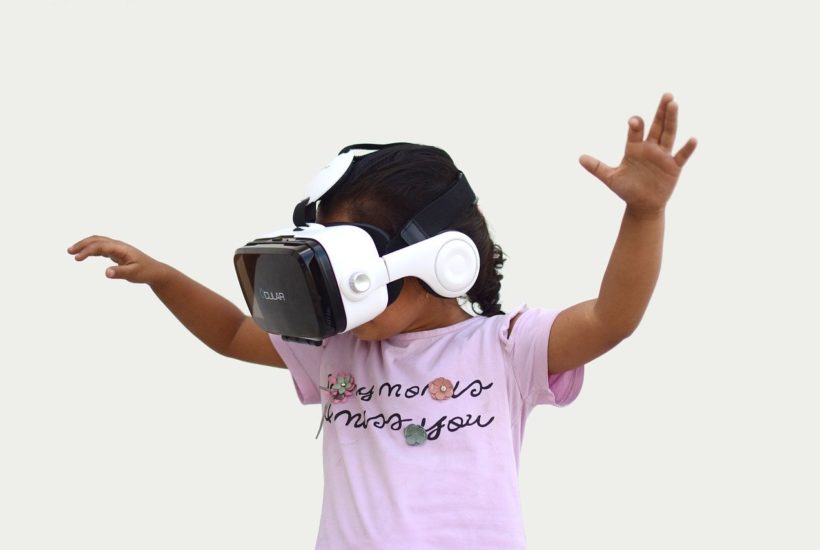Business
Virtual reality in the classroom: How XRApplied is making it happen
A large body of research is making a case for the revolutionary benefits of putting AR and VR in the classroom. Unfortunately, just like all early-stage technologies, high costs and development times have remained prohibitive for institutions seeking to adopt it. But now, as companies like XRApplied find ways to slash the cost and time of development, we are fast approaching a tipping point.

Technology and education have always gone hand in hand. First, students must engage with technology throughout their educational lives to prepare themselves for life in the modern world. Second, the use of appropriate technology in the classroom enhances the educational experience by offering both additional breadth, depth, and interactivity to the learning material that can’t traditional mediums like textbooks and chalkboards simply can’t deliver. Like this, more engaging experiences are created, leading to higher attention spans and greater retention rates. This is why companies like XRApplied are keenly working towards solutions that will enable educators to find uses for the next generation of tech by putting Augmented and Virtual Reality in the classroom.
Of course, there will be some resistance. Like any emerging technology, there are always questions around the “hows” and “whys.” The “hows” are usually in the form of questions like “how are we going to create useful applications with this technology,” and “how are we going to afford to do it?” And the “whys” come as questions like “why is this better than what we already have?”
The first questions—the “how” questions—are ones that XRApplied is in the process of answering. As for the “whys,” there is a significant body of publications from the academic community answering these questions. Notably, much of this is pointing towards AR engendering active learning experiences fostering greater engagement and motivation in students. This is helping AR and VR stand out above many other technologies that have been, or are trying to be, introduced into the classroom.
Why bring Virtual Reality into the classroom?
To illustrate just one potential application for Augmented and Virtual Reality in the classroom, imagine that you’re a language student learning dutch for a moment. You’re reading a text and you’ve just encountered a new word. For the purposes of this exercise, let’s say this word is “vlooienmarkt.”
Traditionally, you’d look up the definition in your bilingual dictionary. In this case, it’s a “flea market.” Normally, you’d jot it down in your notebook, continue with your text, and maybe come back to it for revision later. But you know you’re going to have a hard time remembering it.
One of the most immediate problems with this approach is that your understanding of this new word exists entirely as words in your own language. This is often one of the things that separates native speakers from non-natives; comprehension and production of the second language are only arrived at by ‘translating’ between the native and second language on the fly. A big reason for this is that second language speakers have never ‘experienced’ the language; without lived experiences, the second language remains an academic exercise.
This is important. Aside from increased exposure time, ‘experiencing’ a new language is one of the reasons why language ‘immersion’ is said to work so well for second language learners. For example, learning how to say “flea market” in a foreign language through a dictionary only goes so far, and is easily forgotten. But if you are actually in a flea market, and someone says to you “we are in a vlooienmarkt,” your brain builds a completely different understanding of this word; an understanding that is not only multi-sensory, but also innate. You have no need to resort back to your native language’s words in order to understand it; you feel it just like any word that is native to you.
Already, without even thinking too hard about it, we see just one possible application where Virtual Reality in the classroom has enormous potential. A VR language dictionary would not only provide the learner with a definition in their first language. It would also be able to immerse the learner in the experience of that word. Being surrounded by the sights and sounds, whilst also being told that you are in a flea market, would make retention rates for new words increase exponentially.
Of course, the applications of Virtual Reality in the classroom extend well beyond simple language dictionaries, and educators are already waking up to the potential this new technology has to enhance the educational experience in revolutionary ways. Thus, for those already familiar with the cutting edge in education, the question is no longer “why”—we already know that AR and VR deliver huge benefits. Rather, the big questions that remain now are to do with the “hows,” and this is where XRApplied steps in.
The rollout problem for Extended Reality in education
Extended Reality is no different from any other technological advancement. Consequently, one of the big problems facing it is the same that any new technology must face: the rollout phase. Unfortunately, even if software can be replicated infinitely at next to no cost, hardware has always, and will always, cost money. This is usually even more of a problem at the early stages of any new advancement. Before the fledgling industry has benefited from years of production experience and economies of scale, prices are necessarily orders of magnitude higher.
There is always an inevitable tipping point at which the momentum of a new technology brings new competitors into the marketplace who push prices down. This then encourages even greater numbers of late-early stage adopters to jump on the bandwagon, only adding more momentum to the growing snowball. But getting to that point can be comparatively slow and painful compared to what happens once the tipping point is reached.
How to increase adoption rates of new technology
One alternative to the broadscale rollout of new hardware, however, is to piggyback new technology on top of existing hardware. This is exactly how the internet was rolled out and, even to this day, is how it still functions in many regions of the world—by piggybacking on top of existing Public Switched Telephone Networks (PSTN) using modems. Of course, the experience of the internet delivered over a phone line is not the same as that delivered over dedicated fiber optic cables, but it is more than sufficient to experience almost all of the benefits that the internet has to offer.
Fortunately, for Extended Reality, the technology revolution required to achieve a similar rollout to that of the internet has already occurred—the smartphone. In its most basic form, most smartphones already have everything required to put Augmented Reality in the classroom: a screen, a camera, and positional sensors. And if delivering fully immersive Virtual Reality experiences is the goal, the addition of a folded piece of cardboard that supports the phone and two lenses is all that’s needed; a solution that can be purchased for well under $10 a piece as a retail customer.
But there is still a problem with piggybacking Virtual Reality in the classroom onto smartphones
The problem with putting Virtual Reality in the classroom by piggybacking on smartphones is that either the school would need to provide the smartphones (no longer cost-effective), or that students would use their own which would cause all sorts of hardware and software incompatibility problems.
The incompatibility problems are not so much to do with the ‘adapter’ hardware devices like the Google Cardboard—they tend to be a ‘one size fits all’ solution. Instead, the problems exist as a result of the myriad of different phones that are now available. Not only is there a plethora of different pieces of hardware being used across all of the available devices, but the problem of outdated systems is also a problem—many people continue using older devices long after the manufacturer has stopped providing software updates. This is especially true for children, who often use hand me down devices that older siblings or their parents have as spares.
This complicates Extended Reality development for those attempting to make applications for mass deployment. When developers have to deal with the intricacies and problems that multiple generations of operating systems and hardware bring, a huge amount of overhead is added to any project. This additional overhead often reaches the point where what should have been a simple, quick to execute project balloons into an infeasible giant.
Solving this problem is where XRApplied is focusing most of its attention at this moment. In their minds, by removing the thorn from Extended Reality developers’ sides—the cross-platform problem—Virtual Reality in the classroom becomes far more accessible. Not only is the cross-platform problem solved—but development times for any new application are cut dramatically, lowering the costs even further.
How long until we start seeing VR in the classroom?
Well funded schools at the cutting edge of integrating education technology into their curriculum program are already advancing the introduction of Extended Reality to their students. Current uses of Augmented and Virtual in the classroom include virtual visits to natural environments and habitats, historical sites, cultural events and even to outer space. It is also being integrated into the sciences, being used to teach anatomy and other specialized subjects and art and design classes for the creation of various projects.
But at the moment, the cost of introducing the technology is reserved for the privileged few. Not only is the development cost for new XR applications currently too high, but the inability for it to be distributed across all hardware platforms means recuperating the costs of development must necessarily be done across fewer potential sales—thus, higher prices.
But this is all beginning to change now. The hardware needed is already in the hands of just about every child in the western education system. And now, companies like XRApplied are lowering the costs of putting Augmented and Virtual in the classroom dramatically. With the not-so-gentle push that the COVID-19 pandemic gave us towards the necessity of integrating technology even deeper into current education, we are already living in the era where the next ed-tech revolution will happen.
__
(Featured image by Prashant Sharma via Pixabay)
DISCLAIMER: This article was written by a third party contributor and does not reflect the opinion of Born2Invest, its management, staff or its associates. Please review our disclaimer for more information.
This article may include forward-looking statements. These forward-looking statements generally are identified by the words “believe,” “project,” “estimate,” “become,” “plan,” “will,” and similar expressions. These forward-looking statements involve known and unknown risks as well as uncertainties, including those discussed in the following cautionary statements and elsewhere in this article and on this site. Although the Company may believe that its expectations are based on reasonable assumptions, the actual results that the Company may achieve may differ materially from any forward-looking statements, which reflect the opinions of the management of the Company only as of the date hereof. Additionally, please make sure to read these important disclosures.

-

 Crypto1 week ago
Crypto1 week agoCaution Prevails as Bitcoin Nears All-Time High
-

 Africa5 days ago
Africa5 days agoBridging Africa’s Climate Finance Gap: A Roadmap for Green Transformation
-

 Business3 days ago
Business3 days agoThe TopRanked.io Weekly Digest: What’s Hot in Affiliate Marketing [uMobix Affiliate Program Review]
-

 Biotech2 weeks ago
Biotech2 weeks agoEcnoglutide Shows Promise as Next-Generation Obesity Treatment
























